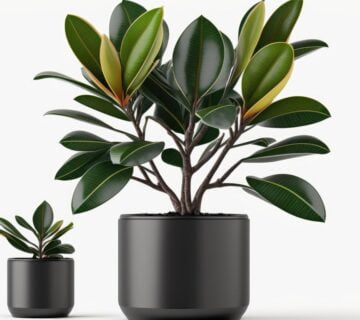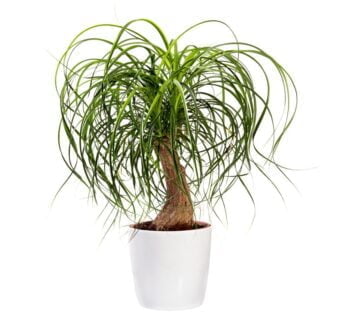Oxalis triangularis – Purple Shamrock
Oxalis, also known as wood sorrels, is a large genus of flowering plants in the family Oxalidaceae comprising about 570 species. The name ‘Oxalis’ is derived from the Greek word ‘oxys’, which means ‘acid’ or ‘sharp’, referring to the sharp taste of the plant’s leaves. These plants are known for their clover-like leaves and attractive flowers.
Many Oxalis species are considered weeds, especially the creeping wood sorrel (O. corniculata) and Bermuda buttercup (O. pes-caprae). Some cultivated species, especially O. tetraphylla and O. deppei, are popular as ornamental plants.
The genus name Oxalis comes from the Greek word oxys, meaning “sour” or “acid”, referring to the sour taste of the leaves. The sour taste comes from oxalic acid, which is toxic in large amounts but present in safe quantities in Oxalis species.
The basic chromosome number of the genus is 10. Some species are diploid with 2n = 20 chromosomes, while others are tetraploid with 2n = 40 chromosomes. A few species have higher ploidy levels.
Types of Oxalis:
– Common Yellow Wood Sorrel (Oxalis stricta): This is a common and widespread species with yellow flowers and clover-like leaves. It is considered a weed in some areas.
– Purple Shamrock (Oxalis triangularis): This popular houseplant has purple leaves and delicate pink or white flowers. It is known for its striking foliage.
– Cape Sorrel (Oxalis capensis): Native to South Africa, this species has small pink or white flowers and spreads rapidly, making it suitable as a ground cover.
– Irish Shamrock (Oxalis acetosella): Native to Europe, this species has three-leafed clover-like leaves and delicate white flowers.
Growing Oxalis:
– Light: Most Oxalis varieties prefer bright, indirect light. Some species, like the Purple Shamrock, can tolerate partial shade.
– Soil: Well-draining soil is essential for Oxalis plants. A mix of potting soil, peat moss, and perlite is suitable for container planting.
– Watering: Oxalis plants prefer evenly moist soil. Water them when the top inch of soil feels dry, but avoid overwatering as it can cause root rot.
– Temperature: Oxalis plants thrive in temperatures between 60°F and 75°F (15°C to 24°C). Some species can tolerate cooler temperatures.
– Indoor vs. Outdoor: Most Oxalis varieties can be grown indoors and outdoors. However, they may need protection from frost if grown outdoors in colder climates.
Care and Maintenance:
Fertilizer:
Use a balanced, water-soluble fertilizer diluted to half-strength during the growing season. Avoid over-fertilization, as it can lead to leggy growth.
Propagation:
Oxalis can be propagated by seeds, division, or bulb offsets, depending on the species. The plants are often self-seed and can spread rapidly in favorable conditions.
Pruning:
Remove dead or yellowing leaves regularly to keep the plant tidy. Some Oxalis varieties may benefit from periodic trimming to encourage bushier growth.
Pests and Diseases:
Oxalis plants are generally not prone to serious pest or disease issues. However, they can be affected by aphids, spider mites, or fungal diseases in humid conditions. Treat any infestations promptly.
Dormancy:
Some Oxalis species, such as the Purple Shamrock, go through a period of dormancy. During this time, reduce watering and place the plant in a fabulous, dark location. New growth will emerge when the dormancy period is over.
Symbolism and Uses:
– Oxalis plants are often associated with good luck, faith, and love.
– Some Oxalis species, like the Irish Shamrock, hold cultural and symbolic significance in Ireland and are associated with St. Patrick’s Day.
– The leaves of certain Oxalis species, such as the Common Yellow Wood Sorrel, have a tart, lemony flavour and can be used in salads or as a garnish.
Toxicity:
While the leaves of Oxalis are edible in small amounts, they contain oxalic acid, which can be harmful if consumed in large quantities. Oxalic acid can cause kidney stones and other health problems.
Conservation:
Many species of Oxalis are common and not threatened, but some are rare and endangered, often due to habitat loss.
Things to know about Oxalis – Purple Shamrock
Common (vernacular) Name
ऑक्सालिस ट्राइएंगुलरिस (Hindi), Oxalis triangularis, False Shamrock, Purple Shamrock, Purple Clover, Love plant, Purple Wood Sorrel, Butterfly Plant, and many more.
Botanical Name
Oxalis triangularis
Origin
South America
Family
Oxalidaceae
Plant Type
Tropical plant
Plant Features
Ornamental / Evergreen / Exotic
Life Cycle
Perennial
Landscape Uses
Container, Walkways, Ground Cover, Mass Planting and Houseplants.
Species
Apricot Cooler Improved, Aztec Pink Magic, Blue Pearl, Cascade Beauty White, Cooler Icy Pink, Cooler Orchid, Cooler Peppermint, Cora Burgundy, Cora Cascade Cherry, Cora Cascade Strawberry, Cora Red, Experimental Dee, Jams and Jellies, Mediterranean Lilac, Mediterranean XP Cherry Halo, Mediterranean XP Rose Halo, Nirvana Pink Blush, Nirvana Red, Nirvana Sky Blue, Nirvana Violet, Pacifica White, Sunshower Lilac, Titian Icy Pink
Varieties
It comes with more than 30 varieties in various leaf and flower colourations.
Size
Height : 1 to 1.5 feet tall and Width : 1 foot wide when mature.
Indoors or Outdoors
Outdoors : Anthurium can be used outdoors in shady plantings; avoid direct sunlight.
Indoors : Excellent plant growth in bright light or indirect light. Best indoor plants for beginners.
Blooming / Flowering
The blooming period is throughout the year.
Flower Colour
It’s come in Pink, White, Purple, Red and Multicoloured.
Lucky Plant
According to Feng Shui, It brings Good Luck in your relationships.
Lighting / Sun Exposure
Bright Indirect Sunlight.
Temperature
Grow best in warm temperatures above 21°C and tolerate max temp. as high as 32°C.
Growth Rate
Anthurium is a slow to moderate grower plant.
Watering
Moderate watering, Mist or overhead sprinkler to provide water and to improve relative humidity. Do not tolerate overwatering, It can cause root damage and leaf yellowing.
Fertilizer
Applying slow-release fertilizer or a water-soluble liquid fertilizer once or twice during the growing season (from spring to summer) is recommended.
i.e., - Cow dung, DAP, Compost, NPK 30-10-10 fertilizer, liquid organic fertilizer etc.
Pruning
Pruning of Anthurium, little is needed. However, trimming away only discoloured or dead leaves.
Propagation
Seeds : The best time to sow your Anthurium seeds is at the end of Winter / early Spring, but it can't give good results.
Stem Cuttings : The easier propagation methods of Anthurium in water or soil via stem cuttings can be done during the warm growing season.
Division : The division of Anthurium can be done in the Rainy season or, better, from February to March.
Dormancy Period
Month : November to February (winter season)
Shed their leaves and show poor growth, Watering minimally.
Avoid : Propagate, Fertilize and Repotting.
Container
Ceramic Pot, Plastic Pot, Terracotta or Clay Pot is preferred, which ensures good drainage and water holding capacity.
Soil Type
A well-drained Loam / Coarse potting soil and water-holding capacity are recommended. Prevent soggy potting medium.
Our recommendation for the potting mix: Equal part mixture of Garden Soil (25%) + Compost (25%) + River Sand (25%) + Cocopeat (25%). You can substitute pieces of Charcoal, Vermicompost, Perlite etc.
Soil pH
Lightly Acidic soil - Ideally, 5.5 to 6.5 pH (potential of hydrogen) is recommended for Anthurium.
Repotting
It is advisable to repot the Anthurium every year or two, preferably during the spring to midsummer season.
Maintenance
Low maintenance and easy to grow.
Properties
The plant poses toxicity risks to both humans and pets if ingested.
Benefits
Excellent indoor air purifier, Anthurium plants turn CO2 into oxygen. It purifies indoor air by removing harmful chemicals like ammonia, toluene, xylene and formaldehyde.
Special Features
It does not attract hummingbirds and pollinators in the same way it does butterflies, bees, or wasps.
Infestation / Pests
Aphids, Scale insects, Thrips, Mealybugs, Spider mites, caterpillars etc.
Diseases / Problem
Physiological Problem : Anthracnose, Leaf Spot and Powdery Mildew.
Bacterial Problem : Bacterial Blight, Bacterial Wilt and Black Nose Disease.
Fungal Problems : Root Rot and Water Mold.
In conclusion, Oxalis is a diverse and fascinating genus of plants with a wide range of uses and characteristics. Whether you’re interested in gardening, botany, or natural history, an Oxalis species will likely catch your interest.
Some Glimpse of Oxalis – Purple Shamrock








No comment